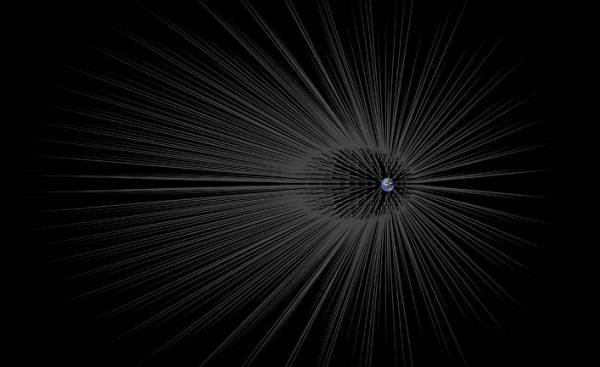
Translation carried out by the project Newочем
I’m sitting at my Desk at the University of Washington and trying to save energy. Lose it not me, but my computer model. Although colleagues could say the same about me. When I tell people that working on speculative theories about dark matter, they start to treat me with suspicion. I don’t think at least someone at the University believes in all this.
In their presentations, I focus attention on how many of the cosmological problems could be solved. Occam’s razor for me a kind of panacea: just one confirmation is so much to explain (Occam’s razor is a methodological principle according to which “it is not necessary to attract new entities without extreme necessity”. Entity in this context — the facts, factors, terms, explaining any phenomenon. — approx. Newочем). I’m talking about things that cannot be explained within the framework of generally accepted ideas about dark matter. The milky Way, obviously, too few satellite galaxies. The internal condition of the small galaxies unstable. Then to my rescue comes again Occam’s Razor and I would argue that these contradictions can be solved by setting the standard dark matter weak samasamajist, a pattern of weak interaction between the particles. Someone may ask if I believe myself in all this. It is difficult to say.
The world we see is an illusion, albeit quite durable. Gradually we tend to think of quantum field theory, which is still a lot of inaccuracies, the true view of the world; we do not always see what is really going on. Dark matter can be considered a good addition to this concept. Apparently, most of the matter in the universe is hidden from us. This is confusing to physicists and the General public. Physics is concerned, it is impossible to give an exact, conclusive definition of dark matter. All the rest is hard to understand something so vague and elusive. All this bears a menacing similarity with how more than a hundred years ago, scientists have challenged the existence of the ether.
In the late 1800s, scientists have tried to understand how electromagnetic waves (e.g. light) can pass through a vacuum. Imagining the waves, we think about water, and then it seems obvious that there must be some medium, the analogue of water, in which electromagnetic waves are ripples. So the idea of “ether” — the elusive medium permeating space.
American scientists albert Michelson and Edward Morley in 1887 he conducted his famous experiment designed to prove or disprove the existence of the ether. If light travels only through air, and — they reasoned — that the Earth moves through the substance. To test this, they built a clever device: durable optical plate is placed in a tank of liquid mercury is prevented the vibration and allowed to rotate the slab in any direction. It was necessary to compare the lengths of light waves aimed in different directions, during rotation of the device or during the movement of the Earth around the Sun. As our planet moves in its orbit against the “ether wind”, it should be reflected on light waves, to reduce their length. After six months, the resistance should change (it will be sent in the opposite direction), and the light beams will again be longer. But, to the surprise of many, the length of light waves in any direction remained unchanged. Didn’t say anything about the existence of the alleged media. The air was a mistake.
However, not all physicists abandoned the ether. This even had a long discussion, at least until there are some supporters of the existence of the ether. Sam Morley did not believe the results of his experiment. Only hindsight has helped to ensure that the Michelson-Morley experiment proves the absence of air and, as it turned out, confirms a more radical theory of relativity of albert Einstein.
Dark matter, dark energy, black money, black markets, black biomass, dark genome: scientists “dim” any important phenomenon that defies understanding or otherwise hidden from direct perception. In other words, this darkness is metaphorical. But initially it was perceived literally. In the 1930s, Swiss astronomer Fritz Zwicky observed a cluster of galaxies, gravitational associated with one another, they moved in their orbits too fast. Only the presence of a huge mass of invisible matter could explain why the galaxies are still holding together. Zwicky suggested that there is dark matter — it just meant that you couldn’t see it. But after him, astronomers found evidence for invisible matter in space. For example, in galaxies themselves, the stars also rotate too fast. It seems that dark matter is the most common substance in the universe.
And yet is the most elusive substance. It does not interact neither with themselves nor with other substances that make up stars, planets or you. The only evidence is the gravitational effects, and gravity, unfortunately, is the weakest type of fundamental interaction. But gravity is also the only universal force, so dark matter dominates in the universe.
For the last 50 years we managed to construct the standard cosmological model convincingly describes the visible part of the universe. First the Big Bang was the cause of the rapid expansion of space, the density was heterogeneous. Over the next 13.7 billion years, these inhomogeneities become more and more obvious thanks to the inexorable force of gravity, presumably forming the “space deck” dark matter, the gravitational field which holds visible to us the bright galaxy.
This standard cosmological model has many factual evidence, including pervasive gamma field of the universe, distribution of galaxies in space and their accumulation. These fundamental observations combine scientific knowledge and independent research in many fields of astronomy. All this is well consistent with the cosmological model, implying the presence of dark matter. Astrophysics, not perceiving seriously the principles of this model remain in the minority. It is not that this theory seems all especially wonderful, simply does not exist to the same coherent and successful alternatives. None of the theories can not explain what dark matter is. This is really one of the greatest unsolved problems in physics.
So the search continues. Particle accelerators process data, the plurality of sensors hidden under the earth, and the telescopes aimed at the sky. The modern era of experiments have shifts strict limits plausible theories. At best, we can understand dark matter in twenty years. In the worst case, we will never understand.
We live in a time of new discoveries. A well-confirmed theory explains the diversity of elementary particles that we can observe. This theory suggests that there are other, as yet unidentified particles. A few decades ago, theorists realized that there may be so-called weakly interacting massive particles (SVMC). Such particles would possess all the properties of dark matter so that she could be right under our noses. If dark matter consisted of SVMC, it would be so weakly interacting with ordinary matter, find that it was only possible as a result of a series of special experiments to study dark matter, which became possible only recently. The most promising of them is “Large underground xenon” experiment (LUX) in South Dakota, the largest dark matter detector in the world. It was built on the site of a mine for the extraction of gold in February 2013 and it is able to detect the most elusive elementary particles. Despite hypersensitivity LUX search for dark matter requires patience. While all that fell into the trap LUX — flare cosmic noise, which do not carry any importance.
The past success of standard paradigms in theoretical physics has led to the fact that we are hunting for a single shared particle dark matter — the dark matter. Perhaps, however, we have no sufficient reason to assume that you can do to find anything.
As stated in the 1994 English physicist John D. barrow: “there is No reason to believe that the universe had to be designed for our convenience”
With this caveat, it seems that the possibilities are as follows. Dark matter either exists or not. If it exists, then we are either unable to detect it or not. If it does not exist, we can either prove that it is not, or can not. Observations that make astronomers claim that dark matter exists first seem too reasonable and convincing enough for them to reject, so the most common argument against the existence of dark matter is a statement that our understanding of gravity is something wrong — that it is not necessarily behaves as predicted by Einstein. It would be turned on the head of our understanding of physics, so few want to understand this. On the other hand, if dark matter exists, but we cannot locate, we will find ourselves in a very awkward position.
But we live in a Golden age of cosmology. Over the past two decades we’ve discovered: measured changes in relic radiation of the Big Bang, found out that the expansion of the Universe is accelerating, glanced at the black holes and was able to detect the brightest explosions in the Universe. In the coming decades, we will likely be able to look at the first stars in the Universe, to map almost full distribution of dark matter and hear the disastrous merger of black holes through gravitational waves. Even among all of these “wealth”, dark matter offers a unique perspective, being at the confluence of new observations, theory, technology and (we hope) new financing.
All offered ways to understand the nature of dark matter can be divided into three categories: artificial re-creation (in a particle accelerator), indirect and direct detection. The last way in which researchers try to catch wimpy (hypothetical weakly interacting massive particles — approx. Newoчем) in “the wild” cause much delight and enthusiasm. The underground LUX detector is one of the first in the new generation of ultra-sensitive experiments. It consists in tracing winow interaction with the nuclei of ordinary atoms. This experiment mostly consists of very pure target detector, such as an intact elemental germanium or xenon, cooled to extremely low temperatures and protected from external particles. The problem is that stray particles still penetrate. Such violations are carefully monitored. Noise reduction, shielding and accuracy in statistical measurements are the only ways to separate the real interaction of particles of dark matter from false alarms.
Theorists have considered many possibilities of how a particle can interact with the wimp. In fact, the first generation of experiments has already ruled out the possibility of the so-called scattering of the particles by interaction with z-boson. What is left is a scattering of particles from colliding with the Higgs boson, which will include the same particle, which was opened in November last year at the Large hadron Collider in Geneva. This implies a very weak interaction, but it is ideal for the current sensitivity of a new generation of experiments.
Again, science says less about what is than what is not, and no discovery has caused quite an interesting restrictions on what can be dark matter. Also under development, which is in its inconsistency reminiscent of the air, they turned a blind eye to some anomalies, the nature of which needs to be clarified. Using another detector such as LUX in the Italian DAMA experiment (a reduction of “DArk MAtter”) claim that they found a modulation signal of dark matter for the year. Critics argue about whether they have a signal. As with air, we expect to see this kind of annual variation during the rotation of the Earth around the Sun, sometimes in the direction of a larger galactic rotation, sometimes against him. Employees DAMA measured an annual modulation. Other competing projects (for example, XENON, CDMS, Edelweiss and ZEPLIN) are unable to do so, but these experiments cannot be directly mapped, so you should defer judgment.
Nature can be cruel. Physics can take the “aviavlasti” as a hint that it’s time to give up, but there’s always the tantalizing possibility that we just need a better experiment. Or perhaps dark matter will prove to be as complicated as normal matter. Previous experiments revealed quite strong limitation on the complexity we can look forward to no prospect to discover the people from dark matter, or even the chemistry of dark matter, believe me — but it still could be us in several guises. We can find some particle that can explain only part of the expected total mass of dark matter.
In a sense, it has already happened. Neutrinos are elusive, but are ubiquitous (60 billion of them pass through a space the size of a little finger every second). They almost never interact with ordinary matter, and until 1988 we thought that they have absolutely no mass. In fact, neutrinos make up a small fraction of the mass of the universe, and they really are a strange kind of dark matter. They are not “the same” dark matter, but perhaps there is no one type of dark matter that we can find.
To say that we live in the age of discoveries really mean to say that we only live in the era of strong interest. Physicists say that we would have achieved something significant, if determined that dark matter is not wimpy. Wouldn’t it be a discovery? At the same time, this branch of physics is teeming with new ideas and competing theories. Some are exploring the idea that dark matter interactions occur, but we will never be able to be involved in them. In this case, the dark matter interactions occur such a tiny scale that they does not impact on the modern cosmology. Dark matter may even be its own exotic universe of dark sector. Such a possibility both frightening and fascinating physicists. We could say that dark matter is a complex Kingdom that will always leave our eyes, with the exception of interaction with our worlds through gravity. Dark sector can be akin to a parallel universe.
Rather just fiddling with the basic idea of dark matter when all your improvements are far-fetched. That’s what I do all theorists dark matter. I developed the idea that dark matter may be simultainously, and added that to the supercomputer to simulate galaxies. On a large scale, where cosmology steadily making correct predictions, this modification does nothing, but on a small scale, when the theory of dark matter, sometimes faltering, she helps solve a few questions. For modeling it is nice to look at, and it can be used to make acceptable predictions. Although there are very many unknowns — what scholars call the “exact settings” — it may seem that some of the results adapted to the observation. That’s why I refrain from judgment and advise you to do the same.
We will probably never know exactly whether dark matter can interact with itself. In the best case, we can assume how strong are these interactions. So, when people ask me whether the correct theory of samasamajist, I answer in the negative. I limit myself to what is possible, but not necessarily so. Frustrating, isn’t it? Of course, cosmology must contain a deeper truth than we can understand.
Maybe one day scientists LUX or their competitors will be able to find what they are looking for. Or I’m using some nondescript supercomputer know the hidden truth about dark matter. However, in this case, this discovery would not be “human”, it will appear suddenly as the result of studies, several of the gods from the machine. The universe is dark matter part of our universe, but we will never be able to accept it.
The nature of epistemological jokes on us What we are seeing, there is only one form, however, the fact that we can’t explore, can exist in an infinite number of States. A good theory should be confusing. Dark matter is a simple solution to a complex problem, not Vice versa. Nevertheless, there is no guarantee that it will ever be able to explain. And no matter astrophysicists will be able to find it in a conceptual sense, we will never be able to understand it. Dark matter will remain outside of our understanding. Whatever it was, to live in the universe, much of which is unavailable, is to live in the realm of infinite possibilities.







